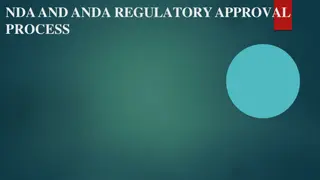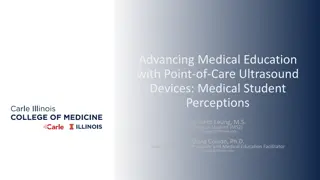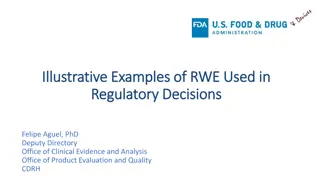Understanding the FDA Approval Process for Medical Devices
The FDA approval process for new medical devices involves rigorous evaluations to ensure safety and effectiveness. Conflicting criticisms of the FDA focus on the balance between tightening or loosening regulations without compromising public health. The agency's mission emphasizes protection and advancement of public health through innovation and accurate information dissemination.
Download Presentation

Please find below an Image/Link to download the presentation.
The content on the website is provided AS IS for your information and personal use only. It may not be sold, licensed, or shared on other websites without obtaining consent from the author. Download presentation by click this link. If you encounter any issues during the download, it is possible that the publisher has removed the file from their server.
E N D
Presentation Transcript
The FDA Approval Process for New Devices Roxana Mehran, MD, MSCAI, FACC, FAHA, FESC Mount Sinai Professor Of Cardiovascular Clinical Research and Outcomes Professor of Medicine (Cardiology), and Population Health Science and Policy Director of Interventional Cardiovascular Research and Clinical Trials, Icahn School of Medicine at Mount Sinai, New York, NY, USA
Disclosures Affiliation/Financial Relationship Company Abbott Laboratories (to institution), Abiomed (spouse), Boston Scientific, Idorsia Pharmaceuticals Ltd. (no fee), Janssen, Medscape, Medtelligence (Janssen Scientific Affairs), Roivant Sciences Inc, Sanofi, Siemens Medical Solutions, Regeneron Pharmaceuticals (no fee), Spectranetics/Philips/Volcano Corp (to institution), The Medicines Company (spouse) Consultant/Advisory/Speaking Engagements Abbott Laboratories, Abiomed, Applied Therapeutics, AstraZeneca, Bayer, Beth Israel Deaconess, BMS, CERC, Chiesi, Concept Medical, CSL Behring, DSI, Medtronic, Novartis, OrbusNeich Research Funding to Institution Bristol-Myers Squibb (to institute), Medtelligence (Janssen Scientific Affairs), Merck (spouse) Scientific Advisory Board Claret Medical, Elixir Medical Equity, <1% Watermark Research Partners DSMB membership paid to the institution ACC, AMA Associate Editor
The FDAs Mission The FDA s Mission The FDA is responsible for protecting the public health by assuring the safety, efficacy and security of medical devices The FDA is responsible for advancing the public health by helping to speed innovations and helping the public get accurate, science-based information
Conflicting Criticisms of the FDA Conflicting Criticisms of the FDA Tighten FDA Regulations! Loosen FDA Regulations! Too many drugs and devices Drug and device approvals are too slow are recalled each year Regulatory processes are under constant scrutiny to identify means of streamlining approval processes without compromising safety and efficacy, the primary mission of the agency.
Conflicting Criticisms of the FDA Conflicting Criticisms of the FDA The United States has arguably the most stringent regulations regarding approval of medical drugs and devices in the world However, about 4,500 FDA approved drugs and devices are pulled from U.S. shelves each year In 2016 alone, manufacturers recalled 4,448 drug and device products, according to the Center for Devices and Radiological Health and the Center for Drug Evaluation and Research Of those recalls, the FDA classified 219 as Class I (i.e. potential to cause serious harm or death) Drugwatch, 2019
Criticisms of Drug & Device Approval Criticisms of Drug & Device Approval Major drug recall list of the history suggest that lots of carelessness is involved during the drug development and manufacturing period. The long list of drug recall on FDA website is evidence that still industries are not following the standard guidelines issued by FDA. - Nagaich & Sadhna, Int J Pharm Investig 2015 Many high-risk medical devices today are approved on the basis of just one clinical trial (as opposed to new medications, which usually require two trials). And only a small minority of clinical studies of medical devices are randomized, controlled and blinded the gold standard for reliable evidence (and the benchmark to which studies of drugs are held). - Redberg & Dhruva, NYT 2015
FDA Annual Devices Approvals: 2009 FDA Annual Devices Approvals: 2009- -2018 2018 2018 set an all-time record for the FDA Gottlieb, fda.gov 2019
Drug vs. Device Approvals: 2009 Drug vs. Device Approvals: 2009- -2018 2018 Although both drug and device approval have increased over the last decade, we see an increasing gap favoring new devices Mezher, RAPS 2019
Steps to Get a New Product to Market Steps to Get a New Product to Market
FDA Medical Device FDA Medical Device Approval Pathway Approval Pathway Van Norman, G.A. J Am Coll Cardiol Basic Trans Science. 2016;1(4):277 87
1. Establish the Product 1. Establish the Product Identify product (device) description Instrument, apparatus, machine, implant, in vitro reagent, including component, part, or accessory Diagnoses, cures, mitigates, treats, or prevents disease or condition Affects structure or function of body Doesn t achieve purpose as a drug Excludes certain software functions data storage, administrative support, electronic patient records Identify purpose Intended use (usually broad) Indications for use (more specific) Duration of use Target patient population (age range; disease)
2. Verify that Product is Medical Device 2. Verify that Product is Medical Device Diagnosis Treatment 3. Identify Classification and Regulatory Pathway 3. Identify Classification and Regulatory Pathway Identify regulatory classification Classification will generally indicate regulatory pathway (premarket submission type) required for device
4. Develop Valid Scientific Evidence 4. Develop Valid Scientific Evidence 21 CFR 860.7(c)(1) requires valid scientific evidence for safety and effectiveness 21 CFR 860.7(c)(2) provides definition of valid scientific evidence 5. Prepare Premarket Submission 5. Prepare Premarket Submission Applicable Laws and Regulations Review Times Evidence Burden Processes
Premarket Submission Types Premarket Submission Types 1. Investigational Device Exemption (IDE) Investigational device to be used in order to collect safety and effectiveness data. 2. Premarket Notification (510(k)) Device to be marketed is as safe and effective, that is, substantially equivalent, to a legally marketed device. 3. Premarket Approval Application (PMA) Demonstrate the safety and effectiveness of the Class III device. 4. De Novo Device has no existing classification regulation. 5. Humanitarian Device Exemption (HDE) Reasonable assurance of safety and probable benefit
Development: Drugs vs. Devices Development: Drugs vs. Devices Drugs Devices Bringing a drug to market takes an average of 12 years Bringing a device to market takes an average of 3 - 7 years Costs for development of medical devices run into millions of dollars $ Costs for development of a new drug is in excess of $1 billion $
Levels of Evidence for Clinical Studies Levels of Evidence for Clinical Studies Drug Requirements Device Requirements For NDA (new drug applications), substantial evidence of drug safety and efficacy is required Most class III devices require Level I or II evidence (i.e. devices that support or sustain human life, or present a potential, unreasonable risk of illness or injury) This means at least 2 adequate and well-controlled Phase III trials with convincing evidence of effectiveness Class III devices that have only minor differences from already approved, predicate devices, may be reclassified as class I or II Some approvals may require more studies Van Norman, G.A. J Am Coll Cardiol Basic Trans Science. 2016;1(4):277 87
FDA Approval Process Similarities FDA Approval Process Similarities Van Norman, G.A. J Am Coll Cardiol Basic Trans Science. 2016;1(4):277 87
Take Home Messages Take Home Messages 1.Although the FDA has continued to make strides in streamlining new drug and device approval processes over the past several years, regulatory processes are often still criticized as being too tight as well as too loose. 2.The FDA must balance the rigor of its approval process (the most demanding in the world) with the needs of patients, without compromising safety or efficacy.
Thank You! Thank You!























